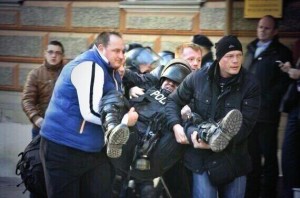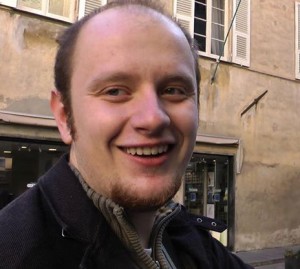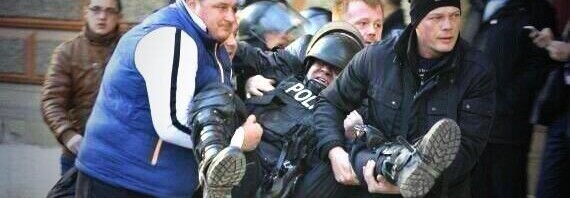 Today marks the first anniversary of the Tuzla protests, with which the bosnian spring of 2014 began. Probably the only one of the popular uprisings in the postcommunist world from the 2011-2014 wave to fire the imagination of leftists of all stripes, it is no more. But Bosnia and Herzegovina will never be the same again. You can learn how it happened then and what is this social movement’s legacy from Mattia Gallo’s interview with Emin Eminagic.
Today marks the first anniversary of the Tuzla protests, with which the bosnian spring of 2014 began. Probably the only one of the popular uprisings in the postcommunist world from the 2011-2014 wave to fire the imagination of leftists of all stripes, it is no more. But Bosnia and Herzegovina will never be the same again. You can learn how it happened then and what is this social movement’s legacy from Mattia Gallo’s interview with Emin Eminagic.
Mattia Gallo: What’s going on in Bosnia Herzegovina a year after the uprising? Where have all the protesters gone? Which part of the social sector is involved in this protest and what are their main claims?
Protestors help an injured police officer in Tuzla
Emin Eminagic: As you know, the protests that started in February last year were a completely novel development in Bosnia and Herzegovina after the war has ended in 1995. The protests finally managed to break away from the ethno-national paradigm, which has been instituted by the Dayton Peace Accords. For the first time in 20 years, social issues were the focus of the public discourse, which, in the very first days of the protests (February 5-6), was even reflected in the media. After a series of unsuccessful protests, on February 5th 2014, the workers of Tuzla’s industrial giants started something no one expected to see happening in Bosnia and Herzegovina. Those giant plants, such as Konjuh, Dita, Resod-Guming and Polihem, were promoted and perceived as providing the main sources of income for the city and its region both during the Yugoslav period and in the first post-war years (1996–2000). However, as a result of their privitization, many people lost their jobs. This was the first protest of its kind in Bosnia and Herzegovina, and the birth of a grassroots democratic movement, which is finding expression through citizens’ assemblies called plenums. The image of the protests was heterogeneous. Nevertheless, the protestors had one thing in common: whether workers, students, elderly, unemployed, they did not belong to the political elite, but came from the ranks of all those discontented with the state of affairs in the country. According to news sources, on the first day of the protests 3,000 people took to the streets and occupied the two main roads in the city, halting traffic for several hours. As rocks were thrown at the Canton Government building, riot police were mobilized to disperse the protests. On February 7th, over 10,000 people gathered in front of the building which housed the Canton Government headquarters, which was then set on fire, after which the protests moved towards the Cantonal Court, which was hit by stones for several hours. Other cities, such as Sarajevo, Bihać, Zenica and others started joining in solidarity protests, and violence followed soon thereafter. Afterwards, in Tuzla, people moved to the Municipality’s headquarters, which was also set on fire. The situation calmed down later in the evening, when the police decided to join the protestors. What ensued in the following days and months after February 7th would prove to be the beginning of a true democratic movement. The movement established a platform in which people engaged in a learning process by rediscovering their own political voices, something, which the ethno-nationalist elites in postwar Bosnia and Herzegovina denied to its citizens through constant threats of new wars and violence, thus alienating people from each other, in an attempt to make them believe that the only sort of community able to exist in Bosnia and Herzegovina today is solely based on ethnicity. These platforms became known all over the country as the plenums (assemblies) of citizens. As I already mentioned, the image of the protests was heterogeneous, including many different people from the Bosnian society today, employed, unemployed, students, elderly people…
In terms of organization of the plenums, the idea was that everyone contributed as citizens, not as organizations, or representatives but as individuals, which was reflected in the decision-making process at plenums: one-person-one-vote. Somehow there was a silent agreement between different initiatives and organizations to remain “out of the picture” in their respective organization’s capacity, but rather people understood the importance of viewing this as a people’s movement, and not a movement of different organizations or civil society actors for that matter. Although it is fashionable to say that the protests did not yield anything concrete, I for one believe this not to be true. Even though the plenums stopped taking place, the effects of the liberation moments can be still felt. For the first time in years, people had a space where they could speak freely without the terror of everyday life, where you are being blackmailed into believing that you are absolutely replaceable. For example, during the catastrophic floods in May of 2014, plenum participants mostly organized the first crisis responses in their respective cities while the government was engaged in politicking games.[1] One important thing to point out is the creation of Sindikat Solidarnosti (Trade Union of Solidarity), an open initiative by the workers of the ruined companies in Tuzla, which is an attempt to fight on an institutional level. The structure of Sindikat Solidarnosti is completely open to anyone, whether you are a worker, unemployed, a student, etc. The demands include, among other things, revision of all privatizations, amnesty for all the protest participants[2], etc.
MG: What are the reactions of the Bosnian media reactions to the protests? What are the reactions of the political class to the protests?
EE: The reactions of both the media and the political elite are the same, as one can safely assume that the media apparatus in Bosnia and Herzegovina works at the behest of the regime. However, at the very beginning of the protest there seemed to be confusion going on in the media. Phrases such as “is this the Bosnian spring”, “people are finally fighting back”, only to be denounced the very next day as acts of hooliganism, terrorism, etc. For example, one of the news reports even stated that the police found 12 kg of drugs among the protesters in Sarajevo, which was a spin by the regime media: drugs were found at a police raid at the edge of the city earlier that day.[3] The elites of course invoked sentiments of the war when the door of the Presidency of Bosnia and Herzegovina was set on fire on February 7th, with statements such as “during the war we defended this building, only to see our children trying to destroy it”.[4] In their desperation, the political elites immediately criminalized the protesters, even proclaiming them terrorists. There also were populist spins to the story in the most cynical manner, with statements given by both leading nationalist and the opposition “the protests are legitimate, but violence must be punished.” This sentiment was also present with the urban petit-bourgeois citizens. One could also witness the effort to ethnicize the protests, with statements by Republika Srpska (RS) politicians such as Željka Cvijanović, the current prime minister of the RS, claiming that the protests were “only possible in a disorganized and democratically immature society such as the Federation of Bosnia and Herzegovina, while they could never happen in a democratic and mature society such as Republika Srpska”, whilst dismissing the social issues the protests addressed. However, the impact of the protests outweighed the empty threats and cynicism at the moment. What was also interesting were the reactions of the International Community, when the High Representative to Bosnia and Herzegovina, Valentin Inzko, a day after the protests have ended, said in an interview with the Austrian national television channel ORF, how he might use his authority to mobilize the EUFOR in order to pacify the situation. At the same time, Ahmed Davutoglu, the then-Minister of Foreign Affairs from Erdogan’s government in Turkey visited Bakir Izetbegović, the Bosniak member of the Presidency of Bosnia and Herzegovina, during the protests, to advise him what to do in a crisis such as this one. One cannot go without joking about the absurdity of their involvement. I like to quip that it’s like having the Austrian Emperor, on the one hand, and the Ottoman Emperor, on the other fighting over the Balkans again, just like in the 19th century. This is all very indicative of the protectorate politics of the International Community towards Bosnia and Herzegovina. The most recent two developments included the mobilization of two additional British platoons during the elections last October in order to “secure the safety of the democratic process”, while local politicians keep arming the police, claiming “we will not take money away from the police”[5].
MG: How would you characterize the state of leftist forces and organizations in the post-Yugoslav space in 2014?
EE: Well, certainly it is a difficult question about the left in Bosnia and Herzegovina today, given that the post-Yugoslav context here differs from Croatia and Slovenia in particular. In Slovenia, for example with the emergence of the United Left (Združena Levica), for the first time since of the breakup of Yugoslavia, we have a political party entering parliament and openly speaking about socialist ideas in a post-Yugoslav country. In a society such as Bosnia and Herzegovina, which is fragmented with the imposition of a multicultural apartheid, it is hard to formulate a strong left with clear goals. This, however is not to say that there are no initiatives in Bosnia and Herzegovina to bring about change and direct it towards a leftist, critical perspective. Even before the protests, for instance, Tuzla had already seen numerous initiatives such as the formation of the Student’s Movement/Student’s Plenum Tuzla. After the protests, as I already mentioned, Sindikat Solidarnosti was established in Tuzla. However, since it has been not even a year after the protests, it is difficult and still too early to say what will happen.
 Emin Eminagic is an activist and researcher in Bosnia and Herzegovina.
Emin Eminagic is an activist and researcher in Bosnia and Herzegovina.[1] See Vuk Bačanović’s analysis on the floods, available at: http://www.bilten.org/?p=961
[2] Many of the participants of the protests are being criminalized, some might be even prosecuted as terrorists.
[3] This was later dismissed as false information by the police. For more see: http://www.radiosarajevo.ba/mobile/novost/140858
[4] See: http://www.klix.ba/vijesti/bih/premijer-suad-zeljkovic-opsovao-novinarki-hayata/140208041
[5] See: http://zurnal.ba/novost/18625/vlasti-u-strahu-za-gusenje-gradanskih-nemira-policiji-kupljena-oprema-vrijedna-23-miliona-km

